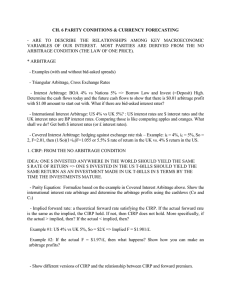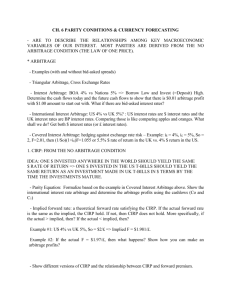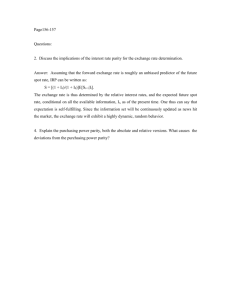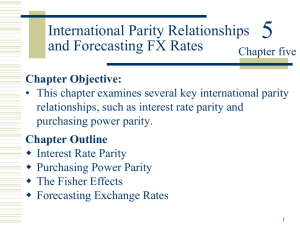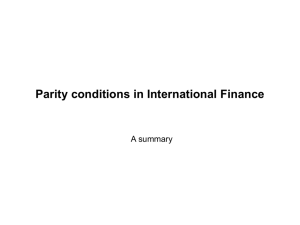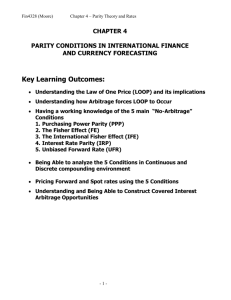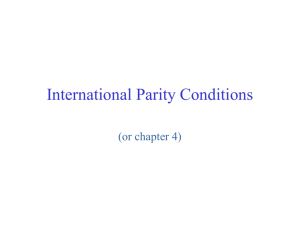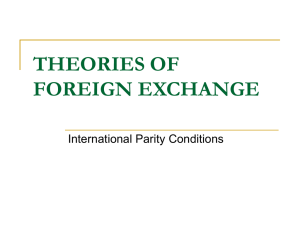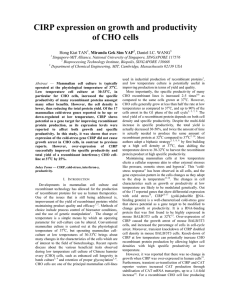Purchasing Power Parity
advertisement
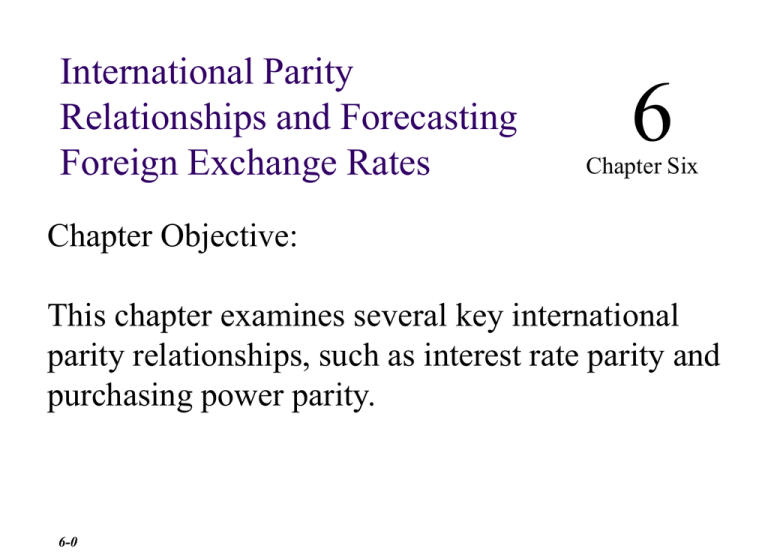
International Parity Relationships and Forecasting Foreign Exchange Rates 6 Chapter Six Chapter Objective: This chapter examines several key international parity relationships, such as interest rate parity and purchasing power parity. 6-0 Chapter Outline Covered Interest InterestRate Interest RateParity Parity Rate Parity (CIRP) Covered Interest Arbitrage Purchasing Purchasing Power Power Parity Parity(PPP): absolute & relative IRP and Exchange Determination PPP Deviations and:Rate the Real Exchange Rate The The Fisher Fisher Effects Effects Domestic & International for Deviations from IRP Reasons Evidence on Purchasing Power Forward Forecasting Forecasting Parity Exchange ExchangeRates Rates Parity PowerApproach Parity Purchasing The Fisher Effects Efficient Market Forecasting Exchange Rates Fisher Effects The Forecasting Exchange Fundamental ApproachRates Forecasting Exchange Rates Technical Approach 6-1 Performance of the Forecasters Covered Interest Rate Parity Defined Idea: $1 (or any amount in $ or in any FC) invested in anywhere should yield the same $ return (or FC return) if the world investment market is perfect! Competitive returns! Otherwise? CIRP is an “no arbitrage” condition. If CIRP did not hold, then it would be possible for an astute trader to make unlimited amounts of money …almost all opportunity. of the time! exploiting the arbitrage Since we don’t typically observe persistent arbitrage conditions, we can safely assume that CIRP holds. 6-2 A Simple Covered Interest Rate Arbitrage Example BOA 4% vs Nations Bank 5% Identify L and H, Borrow Low & Invest (Deposit) High A few issues: Borrow say $1 from BOA and Deposit at NB Cash Flow at 0: +$1 from BOA -$1 to NB => Net CF= $0 Cash Flow at1: +$1.05 from NB -$1.04 to BOA => $0.01 arbitrage gain. 1) Bid-Asked? How about 3.99~3.01% vs 4.99~5.01% 2) Can it be sustained? What is the equilibrium situation, then? What about 4% in the US vs 5% in the UK? Well, we need more info to determine the arbitrage opportunity. Why? Why? US interest rate, i$, is a $ interest rate and the UK rate, i£, is a £ interest rate. It is like comparing apples and oranges. What do you need? Exchange rates! . A Box Diagram to show $ interest rate investing in the UK is 5.5% > 4% Why 5.5% > 5.0%? Investing in UK involves two transactions (or investments)! Borrow from the US and Invest in UK! $1 invested in the US => $1.04 $1 => 0.5 £s at So = $2/ £, or (1/So) £ s Then 0.5 £ s => 0.5*(1.05) = 0.525 £ s, or (1/So)*(1+iBP) £ s To convert £ s to $s, we need the future exchange rate. To have no risks, we use a forward contract with the forward rate, say F=$2.01/ £. Then $ amount is $1.055, or $(1/S0)*(1+i £)*F Arbitrage strategy: Arbitrage profit = $0.015 In equilibrium with no arbitrage opportunity, 1+i$ = (1/So)*(1+i£)*F. CIRP (why Covered?) Covered Interest Rate Parity Defined Consider alternative one-year investments for $1: 1. Invest in the U.S. at i$. Future value = $ (1 + i$) Trade your $ for £ at the spot rate, invest (1/So ) £s in Britain at i£ while eliminating any exchange rate risk by selling the future value of the British investment forward. 2. F Future value = $(1 + i£) × So Since these investments have the same risk, they must have the same future value (otherwise an arbitrage would exist) F (1 + i$) F$/£ = S$/£ × (1 + i ) (1 + i£) × = (1 + i$) So £ 6-6 Alternative 2: Send your $ on a round trip to Britain $1,000 So Step 2: Invest those pounds at i£ Future Value = $1,000 Alternative 1: invest $1,000 at i$ CIRP Step 3: repatriate future value to the U.S.A. $1,000 (1+ i£) So $1,000 (1+ i£) × F $1,000×(1 + i$) = So 6-7 Since both of these investments have the same risk, they must have the same future value—otherwise an arbitrage would exist CIRP Defined Formally, 1 + i$ F = 1 + i¥ So CIRP is sometimes approximated as i$ – i¥ ≈ F – So So 6-8 CIRP and Covered Interest Arbitrage If CIRP failed to hold, an arbitrage would exist. It’s easiest to see this in the form of an example. Consider the following set of foreign and domestic interest rates and spot and forward exchange rates. Spot exchange rate 360-day forward rate 6-9 So = $2.0000/£ F360 = $2.0100/£ U.S. discount rate i$ = 3.00% British discount rate i£ = 2.49% CIRP and Covered Interest Arbitrage A trader with $1,000 could invest in the U.S. at 3.00%, in one year his investment will be worth $1,030 = $1,000 (1+ i$) = $1,000 (1.03) Alternatively, this trader could 1. Exchange $1,000 for £500 at the prevailing spot rate, 2. Invest £500 for one year at i£ = 2.49%; earn £512.45 3. Translate £512.45 back into dollars at the forward rate F360($/£) = $2.01/£, the £512.45 will be worth $1,030. 6-10 Alternative 2: Arbitrage I buy pounds £500 £1 £500 = $1,000× $2.00 $1,000 Alternative 1: invest $1,000 at 3% FV = $1,030 6-11 Step 2: Invest £500 at i£ = 2.49% £512.45 In one year £500 will be worth Step 3: repatriate £512.45 = to the U.S.A. at £500 (1+ i£) F360($/£) = $2.01/£ $1,030 F£(360) $1,030 = £512.45 × £1 CIRP & Exchange Rate Determination According to CIRP only one 360-day forward rate, F360, can exist. It must be the case that F360 = $2.01/£ Why? If F360 $2.01/£, an astute trader could make money with one of the following strategies: 6-12 Arbitrage Strategy I If F360 > $2.01/£ => then LHS<RHS i. Borrow $1,000 at t = 0 at i$ = 3%. ii. Exchange $1,000 for £500 at the prevailing spot rate, (note that £500 = $1,000 ÷ $2/£) invest £500 at 2.49% (i£) for one year to achieve £512.45 iii. Translate £512.45 back into dollars, if F360 > $2.01/£, then £512.45 will be more than enough to repay your debt of $1,030. 6-13 Arbitrage Strategy II If F360 < $2.01/£ i. Borrow £500 at t = 0 at i£= 2.49% . ii. Exchange £500 for $1,000 at the prevailing spot rate, invest $1,000 at 3% for one year to achieve $1,030. iii. Translate $1,030 back into pounds, if F360 < $2.01/£, then $1,030 will be more than enough to repay your debt of £512.45. 6-14 Reasons for Deviations from CIRP Transactions Costs Capital Controls There may be bid-ask spreads to overcome Governments sometimes restrict import and export of money through taxes or outright bans. Different risks 6-15 Transactions Costs Example Will an arbitrageur facing the following prices be able to make money? Borrowing Lending $ 5.0% 4.50% € 5.5% 5.0% Spot Bid $1.42 = €1.00 Forward $1.415 = €1.00 6-16 Ask $1.45 = €1,00 $1.445 = €1.00 Purchasing Power Parity Purchasing Power Parity and Exchange Rate Determination PPP Deviations and the Real Exchange Rate Evidence on PPP 6-17 Purchasing Power Parity and Exchange Rate Determination The exchange rate between two currencies should equal the ratio of the countries’ price levels (Absolute PPP): So = P$/P£ Alternatively, P$ = So*P£, Price level in each country determined in the same currency ($) should be the same in both countries. What you can buy with $100 should be the same anywhere in the world. => Living costs are the same! Relative PPP If Absolute PPP holds at each point in time, say at t=0 and t=1, then We can show that %chg in the exchange rate (=(S1So)/So, FC appreciation rate relative to $) is equal to the difference between the %chg in the US price level (=US inflation rate) and the %chg in the UK price level (=UK inflation rate), E(e) = E(π$) – E(π£) If the inflation rate in the U.S. is expected to be 5% in the next year and 3% in the euro zone, Then the expected change in the exchange rate in one year should be 5 - 3=2%, euro is expected to be 2% stronger against $ Make sense? Fisher Equations Domestic (Closed) i$ = ρ$ + E(π$), 1+i$ = (1+$)*(1+E($)) to be exact International (Open) - i£ = E(π$) – E(π£) Relative PPP + International Fisher E(e) = E(π$) – E(π£) = i$ - i£ i$ Assuming that ρ$ = ρ£ , Evidence on PPP PPP probably doesn’t hold precisely in the real world for a variety of reasons. Non-tradable goods like services, perishable products Transactions & Transportation costs including tariffs, etc. Different consumption baskets PPP-determined exchange rates still provide a valuable benchmark. 6-21 Forward Parity F = E(S1) (F – So)/So = (E(S1) – So)/So = E(e) Approximate Equilibrium Exchange Rate Relationships E(e) (i$ – i¥) ≈ Rel PPP ≈ CIRP ≈ Int Fisher 6-23 E($ – £) ≈ Fwd Parity F–S S Forecasting Exchange Rates Efficient Markets Approach Fundamental Approach Technical Approach Performance of the Forecasters 6-24 Efficient Markets Approach Financial Markets are efficient if prices reflect all available and relevant information. If this is so, exchange rates will only change when new information arrives, thus: St = E[St+1| It] and/or Ft = E[St+1| It] Predicting exchange rates using the efficient markets approach is affordable and is hard to beat. 6-25 Fundamental Approach Involves econometrics to develop models that use a variety of explanatory variables. This involves three steps: step 1: Estimate the structural model. step 2: Estimate future parameter values. step 3: Use the model to develop forecasts. The downside is that fundamental models do not work any better than the forward rate model or the random walk model. 6-26 Technical Approach Technical analysis looks for patterns in the past behavior of exchange rates. Clearly it is based upon the premise that history repeats itself. Thus it is at odds with the EMH 6-27 Performance of the Forecasters Forecasting is difficult, especially with regard to the future. As a whole, forecasters cannot do a better job of forecasting future exchange rates than the forward rate. The founder of Forbes Magazine once said: “You can make more money selling financial advice than following it.” 6-28
